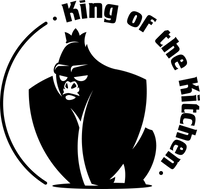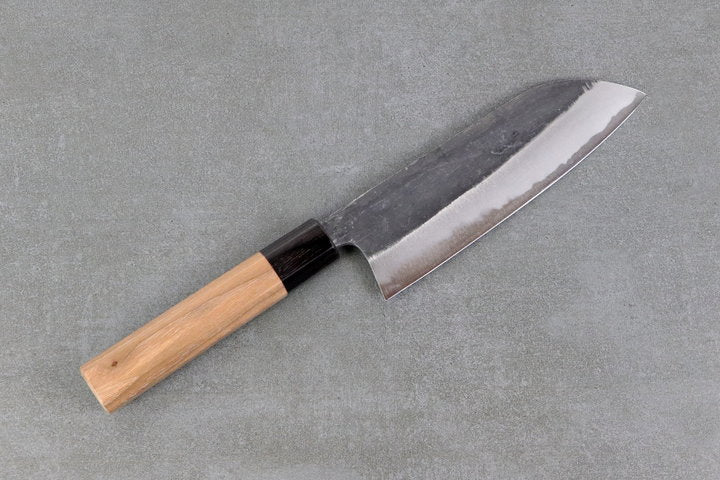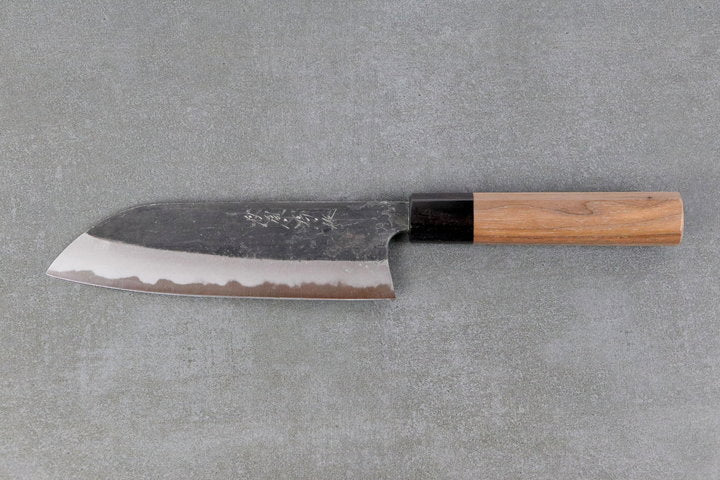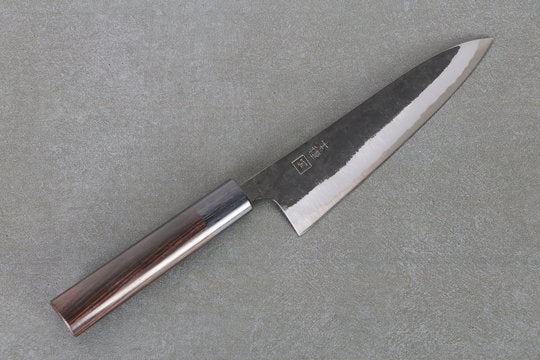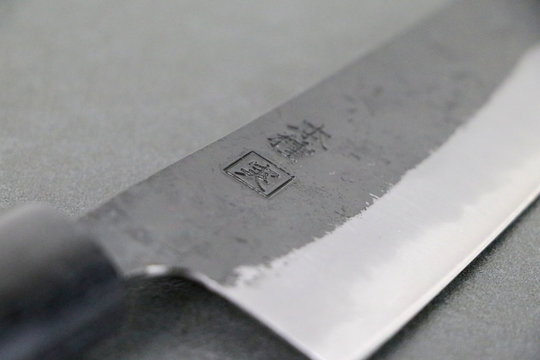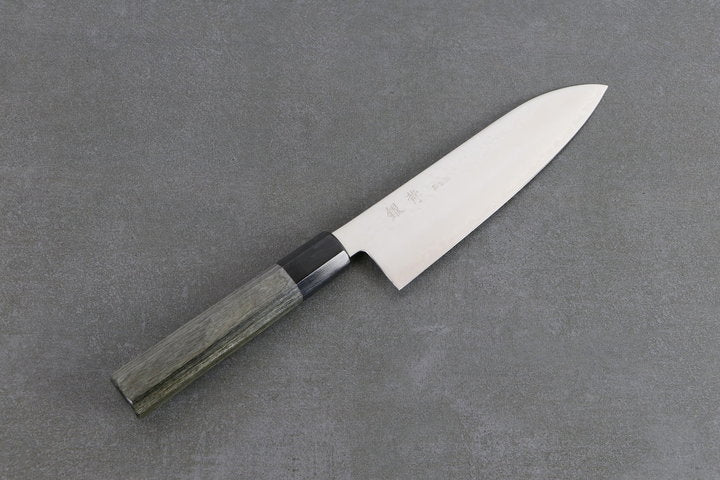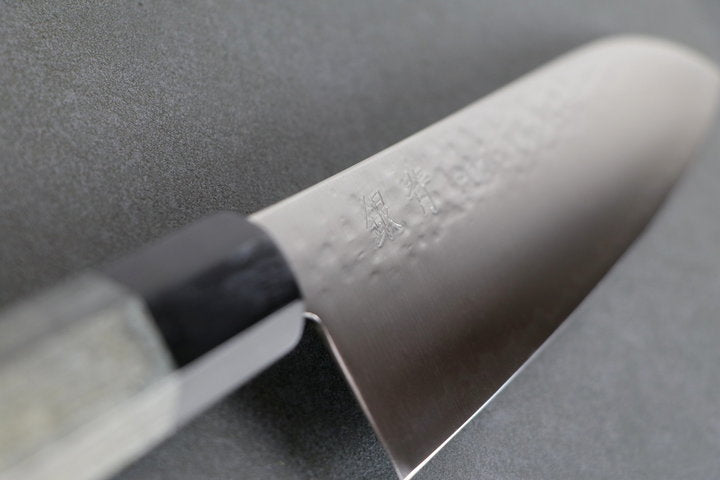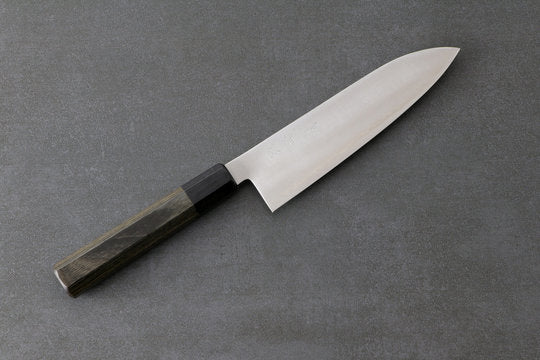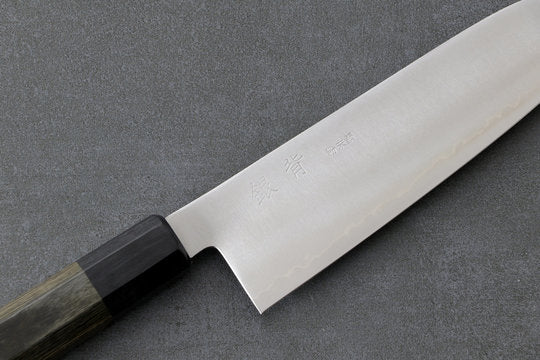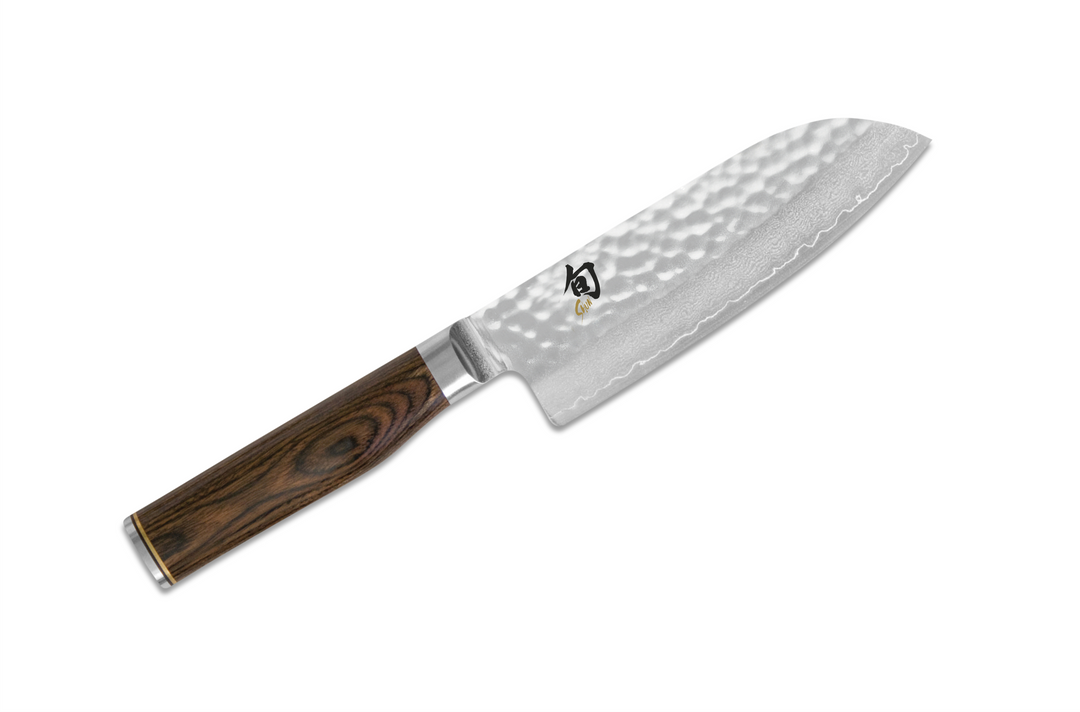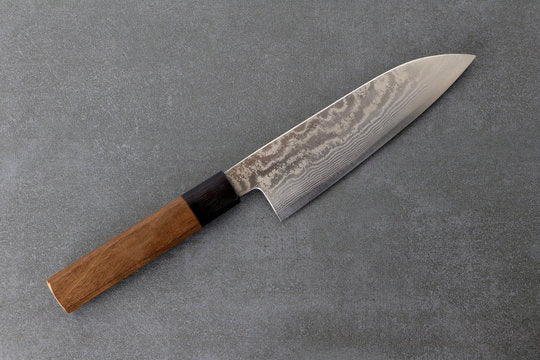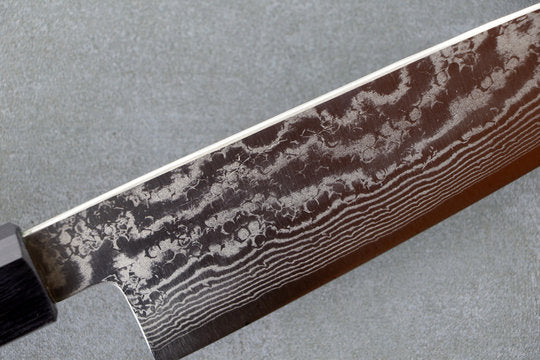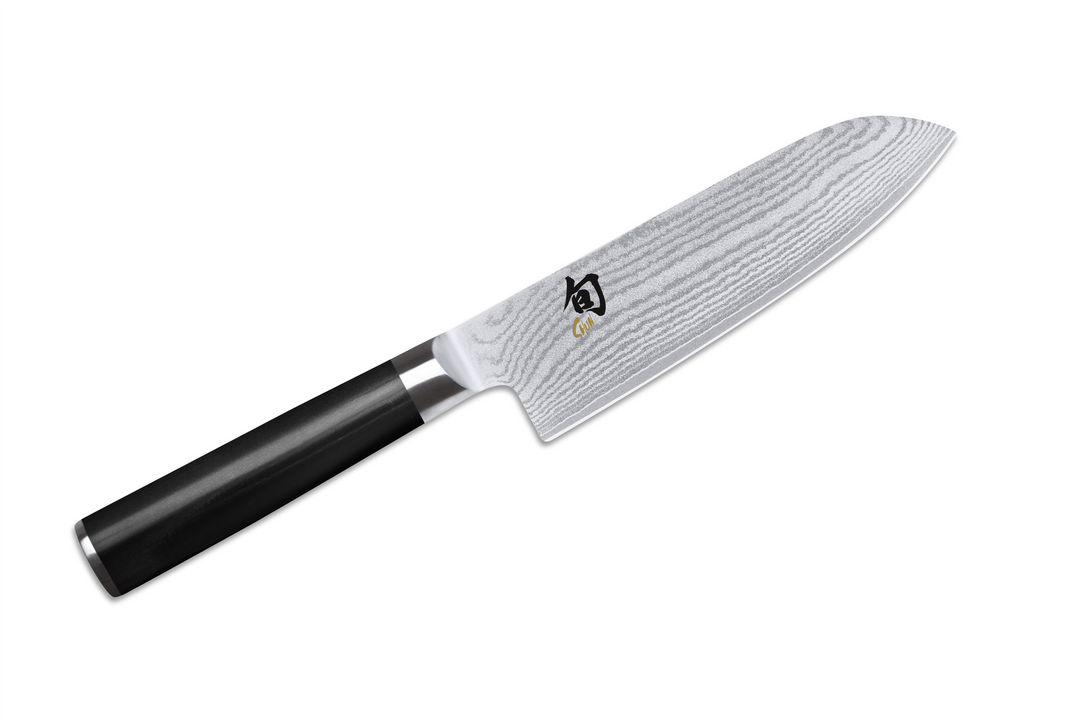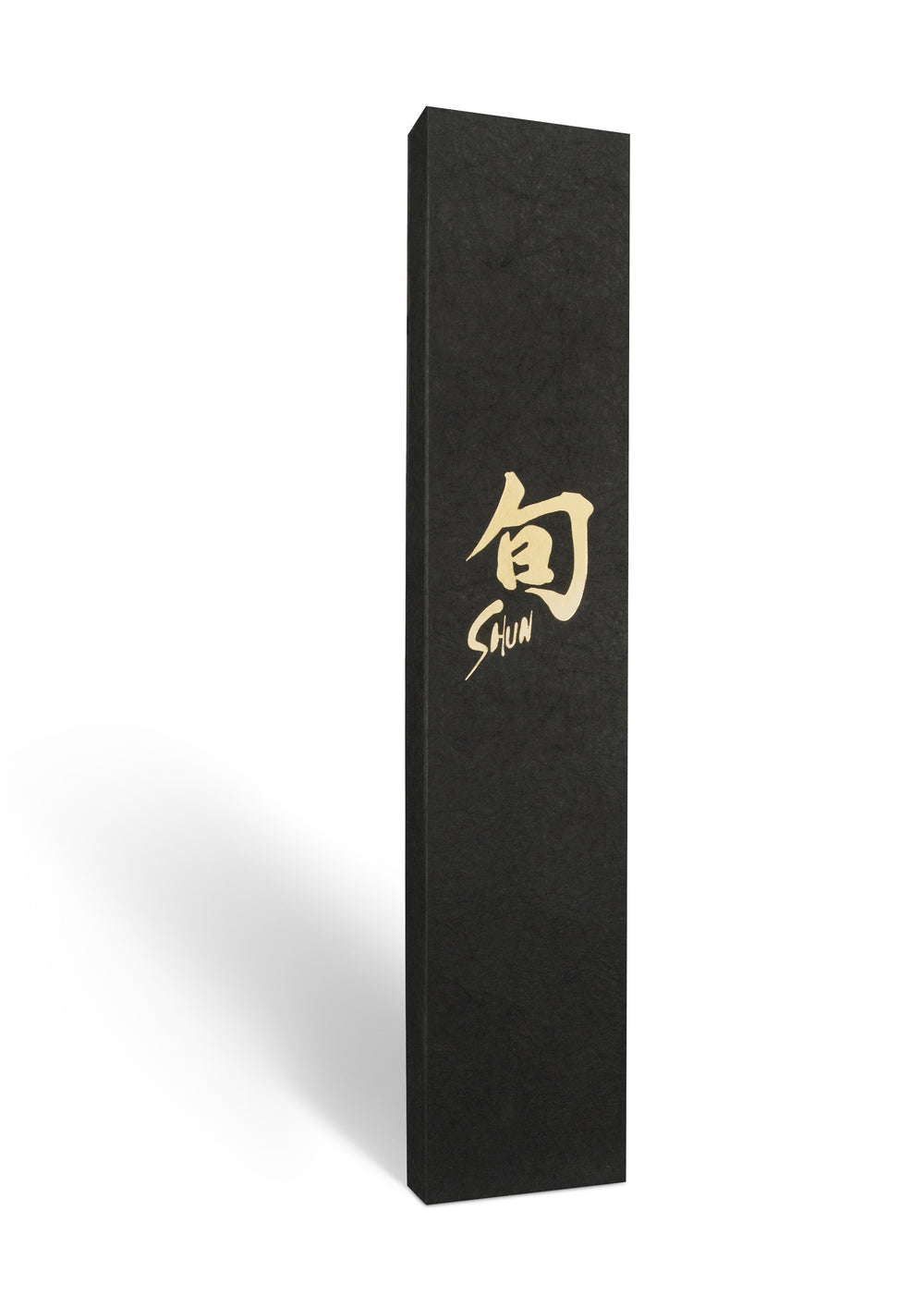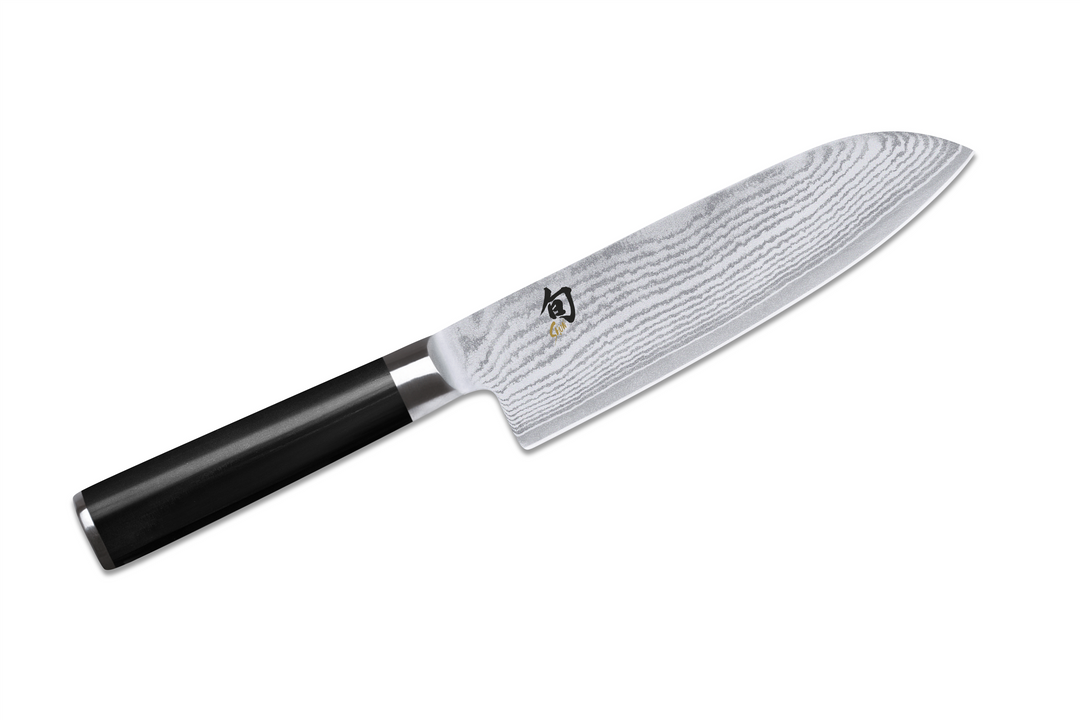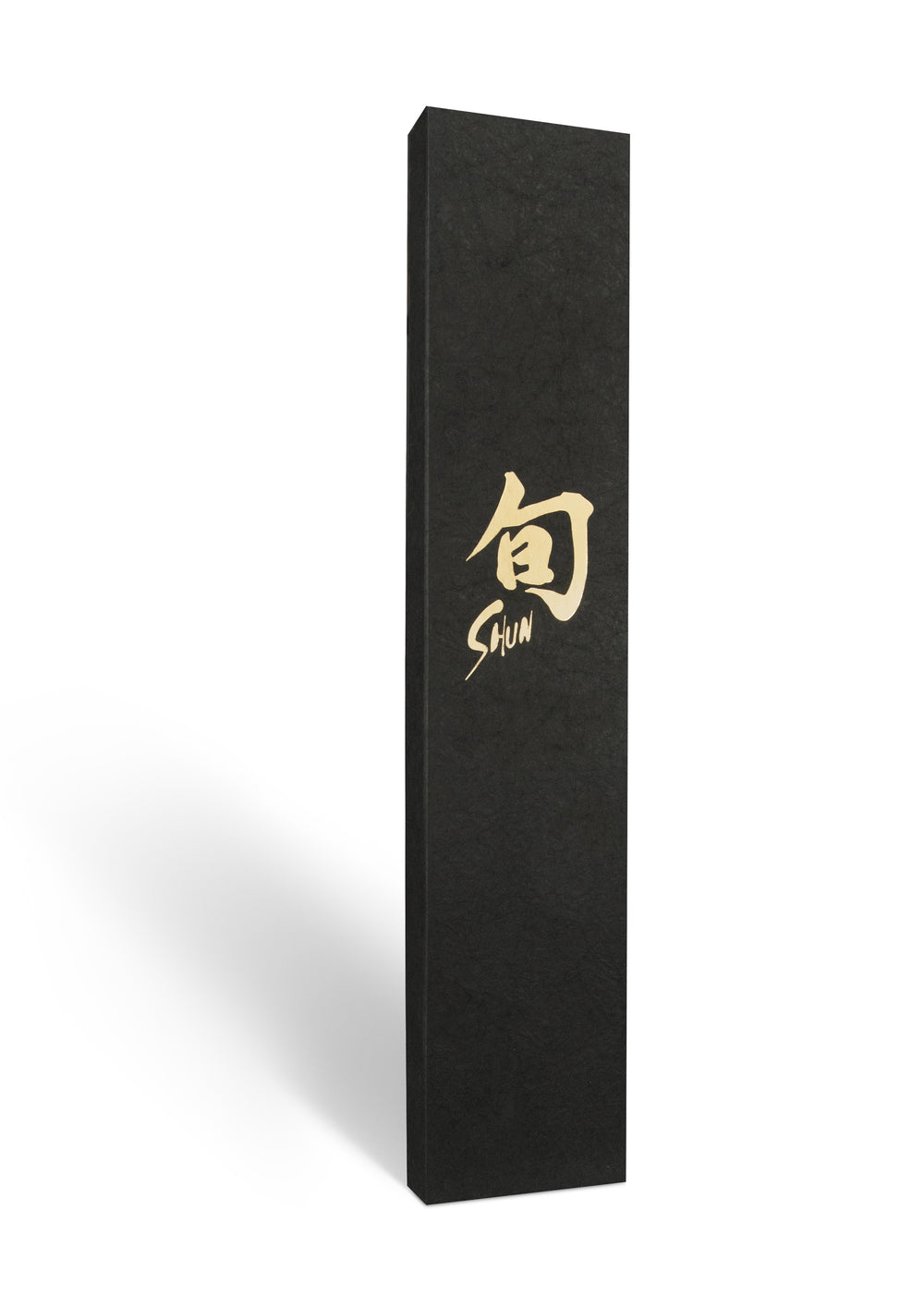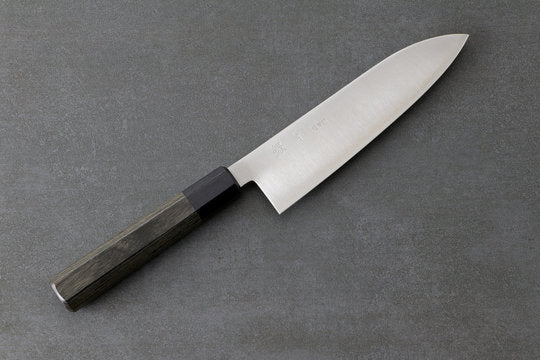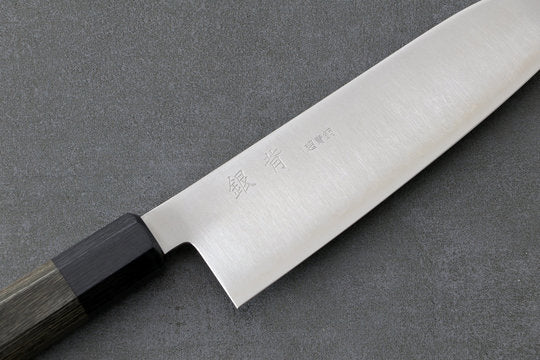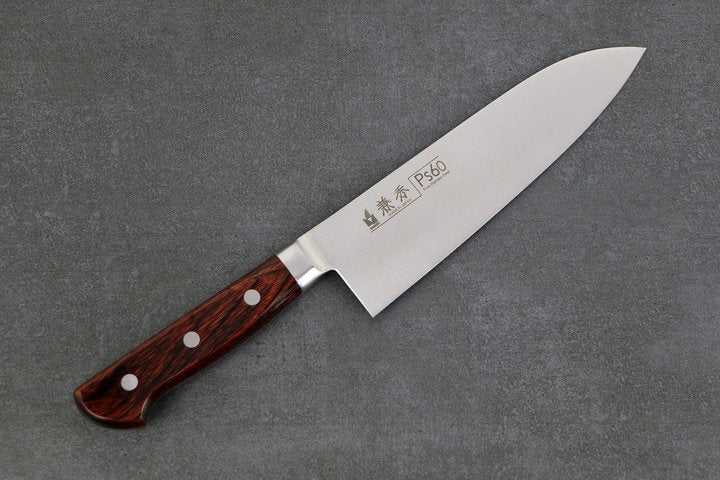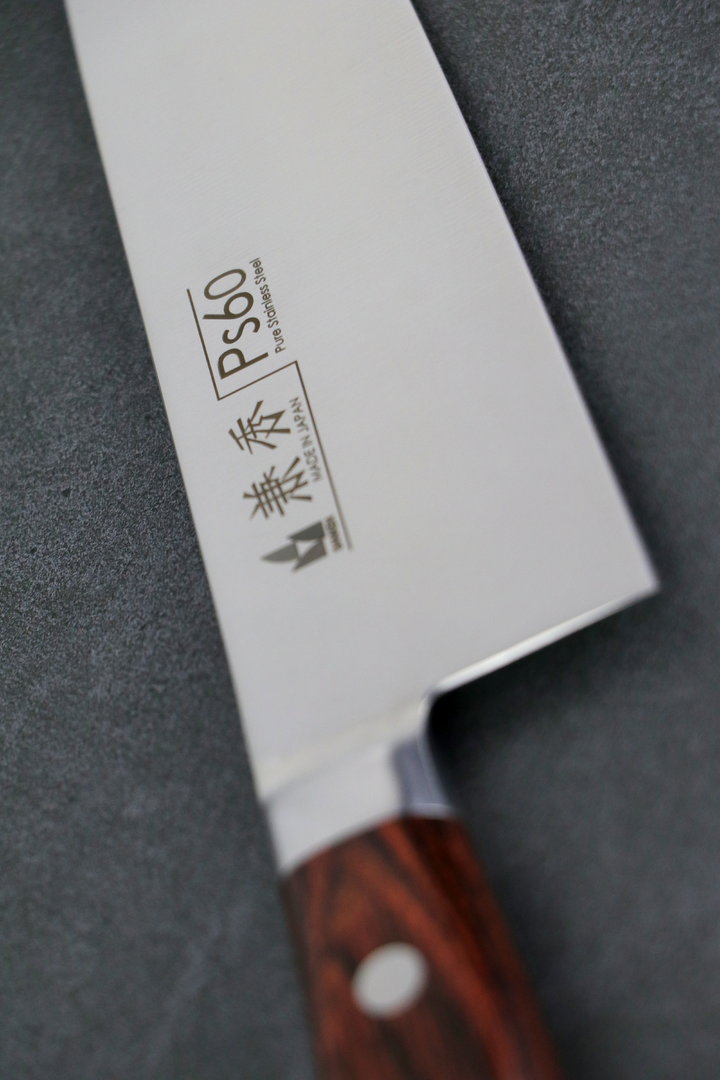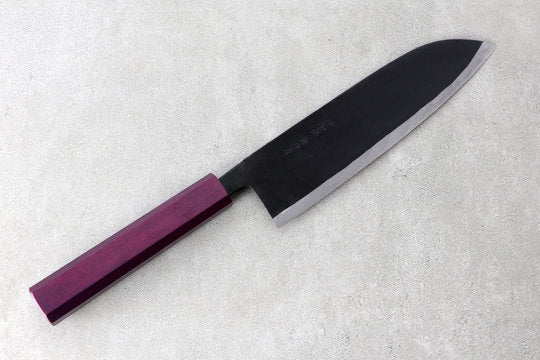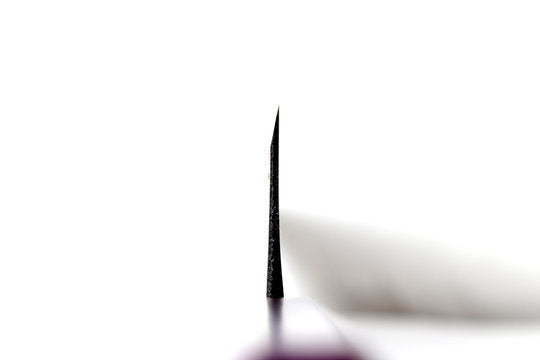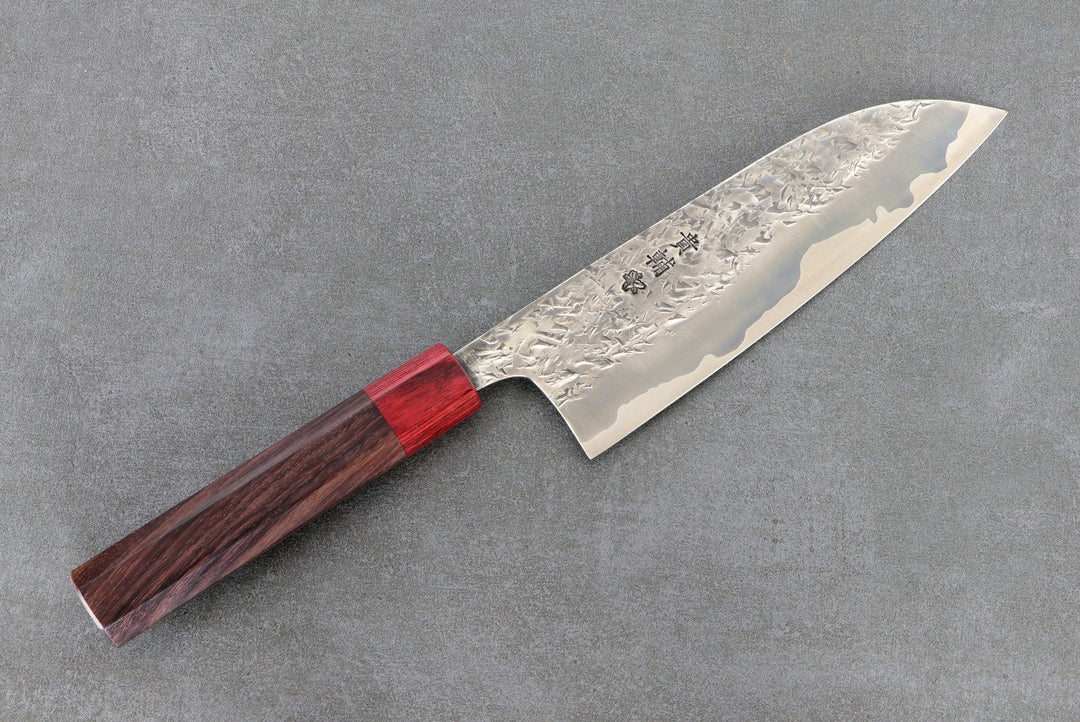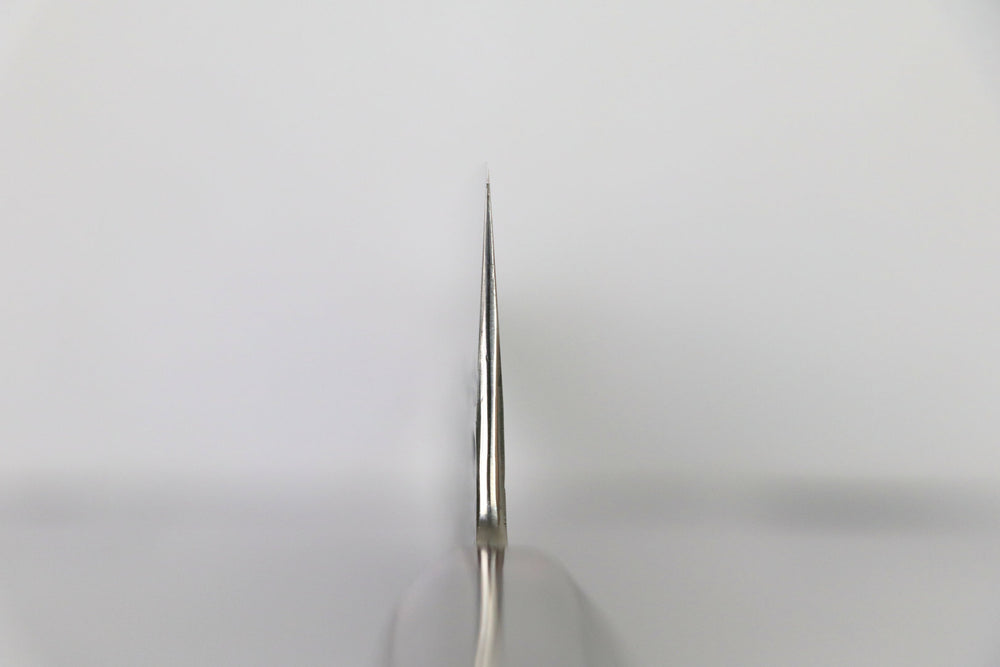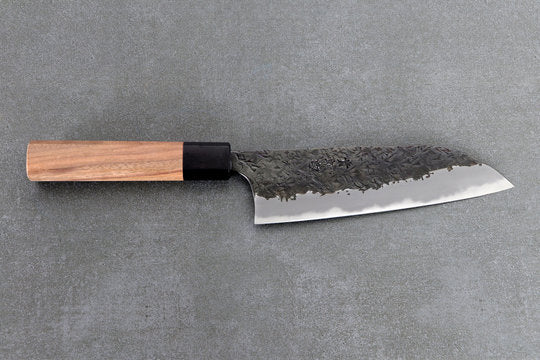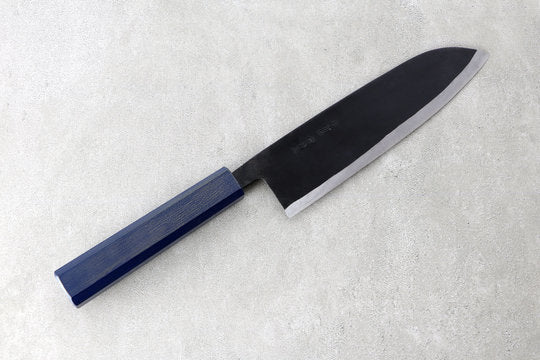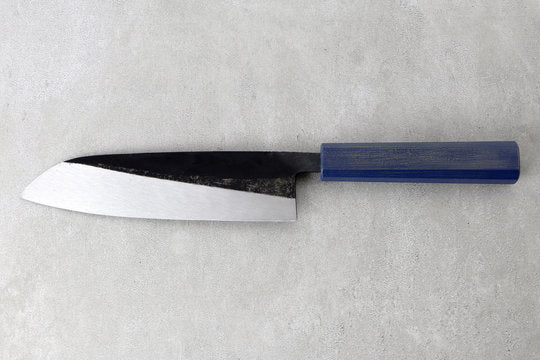
WHAT IS A SANTOKU KNIFE USED FOR?
No Japanese knife is better known than the Santoku knife with its striking blade shape. It is universally applicable and can be used for fish, meat and vegetables. So if you are looking for an all-purpose knife for basic kitchen equipment, a Santoku knife is the right choice.
The blade length of about 15 cm - 18 cm reflects these all-rounder qualities. With this size, the slightly larger cut can be handled as well as more delicate work, e.g. cutting your food into fine strips. As a little tip, thanks to the back of the blade, the ingredients can be pushed into the pot for further preparation.
The Santoku chef's knife is popular all over the world and usually has the following features:
- Blade length from 15 cm to 18 cm
- Rectangular blade shape with relatively high blade blade and sickle-shaped blade tip
- Cutting edge ground on both sides, therefore suitable for right-handers and left-handers
- Ideal for cutting fruit and vegetables as well as fish and meat
Santoku - all-purpose knife of the three virtues
Santoku in German means knife of the three virtues. With this translation, chef's knives Santoku are already well described, because they are equally suitable for cutting meat, fish and vegetables. In the meantime, they have proven themselves in the kitchens of this world, offering the characteristics of an all-purpose kitchen knife. This chef's knife is the perfect all-purpose knife and accordingly widely used!
Usually it has a blade with 18cm length, which is ideal for use with fish, meat and vegetables and the shape of the knife characterizes the appearance of this chef's knife. Traditional Japanese knives are constructed of three layers of steel. The layers on the outside determine the appearance enormously, but the core of the blade is responsible for the sharpness and the possible sharpening. The harder the steel of the middle layer, the sharper a knife can be and the less effort is needed to cut. Damascus knives can also have multiple layers, but a distinction must be made here. Folded Damascus is not the same as a Japanese knife made of 3 layers of steel with an extra sheathed cutting core of carbon steels.
USE SANTOKU KNIFE FOR WHAT
The santoku knife is a very common Japanese blade shape for all-purpose kitchen knives or utility knives. The wide blade of the santoku provides enough space for the fingers under the handle and allows the blade to be neatly guided by the back of the finger when cutting. For precise and speedy chopping of meat, fish and vegetables into fine strips, these kitchen knives are ideally suited.
The blades of Santoku knives typically have a blade length between 16 cm and 18 cm and can therefore also be used for larger cut material. Compared to the also well-known kitchen knife Gyuto, this Japanese knife has a more striking knife shape and can be easily recognized due to the high blade.
At Silverback Knives you will find hand forged santoku knives from traditional cutlers. The high blade and the crescent-shaped tip in the radius, also called Kamagata tip, make these knives a perfect kitchen knife. The blade shape of the allows the use of various cutting techniques, such as the cradle cut (rolling over radius of the tip), or the chopping technique, for example, for chopping herbs with the straight blade area near the handle. Thus, the Santoku knife is clearly a universal knife from Japan, as it combines many advantages of a knife blade.
SHARPENING SANTOKU KNIVES
Hand forged Japanese knives are best sharpened with water sharpening stones. Our product selection, regardless of brand, should also be sharpened with these grinding accessories. Our robust natural water whetstone is suitable for fine sharpening, for experienced users of whetstones we also have somewhat more sensitive stones on offer (whetstone set professional), with which the full potential of the Japanese knife steel of a Japanese knife can be worked out.
Our range of sharpening stones covers all requirements from basic sharpening (slightly coarser grain of the sharpening material) to fine sharpening (ultra-fine grain of the sharpening stone). Which stone should be used depends on the condition of the blade. If a chef's knife has a very worn blade, a basic grind should be made first, followed by the fine grind.
If the blade is used and sharpened regularly, it is usually sufficient to use a fine to ultra-fine grit for the fine grinding. In any case, we do not recommend the use of sharpening rods or sharpening steels. These sharpening tools are not suitable for Japanese knives made of carbon steel and should therefore not be used with this chef's knife! The sensitive cutting core, i.e. the knife blade, should not be stressed by possible blows to the blade. Thus, if a sharpening steel is not used 100% correctly, it can cause a lot of damage to the cutting core of the knife blade.
THE BEST SANTOKU KNIFE
As individual as each person's demands on their kitchen knives are, the question of the best santoku can be answered just as differently.
Basically, any of our kitchen knives can be the best choice for the individual. Certainly, a chef's knife with a sharp edge that requires little effort to use is an asset to kitchen work. However, in order to decide for yourself which knife suits you best, there are some criteria you can pay attention to:
HOW FREQUENTLY IS THE SANTOKU KNIFE USED?
As an all-purpose chef's knife, the santoku is generally used on a very regular basis. From our point of view, a good santoku should be part of the basic equipment in the kitchen. Accordingly, you should pay attention to the quality of workmanship when selecting, because only a well-made specimen gives the cook long pleasure and makes clean cuts possible through a sharp cutting surface.
All Japanese knives in our store are made by traditional cutlers and are, with proper care, a very durable tool. Get with the chef's knife of the three virtues real tradition in your kitchen and achieve optimal results when cutting the products.
WHAT IS A SANTOKU KNIFE USED FOR?
It is universal and can be used for fish, meat and vegetables. So if you are looking for an all-purpose knife for the basic equipment in the kitchen, a santoku knife is the right choice.
The blade length of about 16cm - 18cm reflects these all-rounder qualities. With this size ds can handle slightly larger cut as well as more delicate work, such as cutting your food into fine strips. As a little tip, thanks to the back of the blade, the ingredients can be pushed into the pot for further preparation.
THAT'S WHY SANTOKUM KNIVES ARE SO SHARP
Sharpness is clearly one of the most important criteria when choosing a santoku. In this context, the edge retention also plays a major role, which determines how long a knife keeps its sharpness. Basically, very high carbon steels are harder and sharper than steel with a lower carbon content.
Among the hardest and sharpest steel grades are all the Shirogami and Aogami steel grades from Japan. Slightly lower degrees of hardness are offered by the low-maintenance steel grades VG 10, AUS10 and Gin 3 (Silver 3). With the knife steels ATS-34, HAP40ZDP189, two steels have reached the market that combine the advantages from the worlds of high-carbon and low-carbon steel grades: Due to their hardness, which is measured in Rockwell, they offer excellent sharpening potential and at the same time are hardly susceptible to corrosion.
In our store you will find Japanese Santoku knives with different core steels to meet the individual requirements of our customers. Especially the steel of the knife has a decisive influence on the surface of the blade. Therefore, this selection should be considered when buying a kitchen knife.
The appearance of the Santoku knife
The appearance can also be decisive for a purchase. Decisive for the appearance are the steel used, the surface finish as well as the surface structure of the blade and the wooden knife handle. The blade shape is very similar for all santokus. Depending on your personal taste, you can find various options with very different looks in our store.
Some customers see in a Japanese knife also a collector's item and therefore reach for very artfully made specimens with a special surface structure (e.g.: Tsuchime or Kurouchi finish).
Also available, however, are variants that are designed for performance and robustness. This chef's knife enjoys great popularity and its concise blade is for many chefs the epitome of Japanese chef's knives.
Ergonomics of the santoku knife
As chef's knives, santokus are generally used on a very regular basis. They are also often the entry point for chefs into the world of Japanese knives. Therefore, it is of course important to ensure that you work with a knife with which you feel confident, that is, that ergonomically fits you. For this feeling is mainly the balance or balance, the handle (or the feel and shape of the handle) and the weight and length of the knife.
All Santoku in our store are excellently balanced, so the knives can be guided very cleanly and precisely and do not tire the user when it is held in the hand for a long time while chopping the ingredients.
Santoku knife handle
The wooden handle is ultimately a matter of taste. Some customers prefer natural handles without edges. Other customers prefer lacquered handles that are octagonal in design. The Santoku in our store have blade lengths between about 16cm and 18cm, which makes them perfect as kitchen knives for most cutting tasks. With these blade lengths it is still relatively compact, larger items to be cut such as a cabbage head or larger pieces of meat can still be precisely cut.
The weight of such a universal knife also depends significantly on the steel used. There is a wide range here, for example, the knives from Misuzu feel light as a feather at just under 100 grams. A Kisuke ATS-34 Santoku with a little over 160 grams is much heavier in the hand.
Ultimately, it is once again a question of personal taste which variant you choose.
WHICH SANTOKU TO BUY?
You should buy the santoku knife that best meets your own needs. The price can only be used to a limited extent as a quality criterion for a chef's knife. As a small guideline, the above-mentioned criteria of frequency of use, quality of workmanship, intended use, sharpness and edge retention, ease of care, appearance and ergonomics can be used.
At Silverback Knives you will find the right knife with the desired blade for every taste. We have a balanced selection of products from abroad (mostly Japan).
Fluted edge SANTOKU
The basic advantage of a serrated knife is that food adheres less strongly to the blade. This effect is caused by the air pockets between the blade and the food to be cut. However, this effect of poor adhesion can be achieved not only by the fluted edge, but also by other surface structures, such as the Tsuchime finish from Kisuke. Such a surface not only offers the described advantage that the food detaches better from the blade, but also makes a great visual impression.
SANTOKU KNIFE CARE
The care of a kitchen knife, like its sharpness, depends largely on the blade steel used. High-carbon steels (aogami, shirogami) are more susceptible to corrosion than lower-carbon steels. This means that with high-carbon steels, care should be taken to clean and dry the blades quickly after use. For chef's knives
